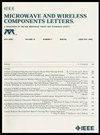巴比尼原理在不同基材界面上互补金属元素的推广
IF 3.3
2区 工程技术
Q2 ENGINEERING, ELECTRICAL & ELECTRONIC
引用次数: 2
摘要
在这封信中,现有的Babinet原理被扩展到不同基底界面上的二维互补金属元素。具体来说,现有的Babinet原理要求均质衬底覆盖互补的金属元素。为了打破这一限制,引入有效相对介电常数的概念,保持原边界条件不变。进一步,将扩展的Babinet原理表示为包含衬底界面上互补金属元素矢量场的数学方程。特别地,所提出的理论关系到有效介电常数的准确性。为了验证所提出的理论,将扩展的Babinet原理应用于具有近似有效介电常数的互补超表面。理论和模拟结果有很大的一致性。因此,扩展的Babinet原理不仅为分析基片界面上互补金属元素提供了理论途径,而且极大地丰富了现有Babinet原理的物理内涵。本文章由计算机程序翻译,如有差异,请以英文原文为准。
Extension of Babinet Principle to Complementary Metallic Elements on the Interface of Different Substrates
In this letter, the existing Babinet principle is extended to two-dimensional complementary metallic elements on the interface of different substrates. Specifically, the existing Babinet principle requests homogenized substrate to cover complementary metallic elements. In order to break this restriction, the concept of effective relative permittivity is introduced to keep the original boundary condition unchanged. Further, the extended Babinet principle is expressed as a mathematical equation including vector fields of complementary metallic elements on the substrate interface. Especially, the proposed theory is related to the accuracy of the effective permittivity. In order to verify the proposed theory, the extended Babinet principle is applied to complementary metasurfaces with the approximate effective permittivity. Great consistence exists between theoretical and simulated results. Thus, the extended Babinet principle not only provides a theoretical approach to analyze complementary metallic elements on the substrate interface but also greatly enriches the physical connotation of existing Babinet principle.
求助全文
通过发布文献求助,成功后即可免费获取论文全文。
去求助
来源期刊

IEEE Microwave and Wireless Components Letters
工程技术-工程:电子与电气
自引率
13.30%
发文量
376
审稿时长
3.0 months
期刊介绍:
The IEEE Microwave and Wireless Components Letters (MWCL) publishes four-page papers (3 pages of text + up to 1 page of references) that focus on microwave theory, techniques and applications as they relate to components, devices, circuits, biological effects, and systems involving the generation, modulation, demodulation, control, transmission, and detection of microwave signals. This includes scientific, technical, medical and industrial activities. Microwave theory and techniques relates to electromagnetic waves in the frequency range of a few MHz and a THz; other spectral regions and wave types are included within the scope of the MWCL whenever basic microwave theory and techniques can yield useful results. Generally, this occurs in the theory of wave propagation in structures with dimensions comparable to a wavelength, and in the related techniques for analysis and design.
 求助内容:
求助内容: 应助结果提醒方式:
应助结果提醒方式:


